七年级下册英语语法《一般现在时》知识点整理
- 格式:docx
- 大小:17.37 KB
- 文档页数:4
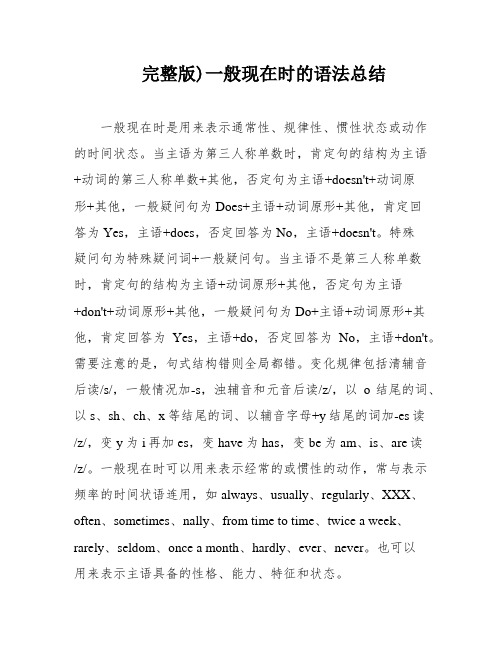
完整版)一般现在时的语法总结一般现在时是用来表示通常性、规律性、惯性状态或动作的时间状态。
当主语为第三人称单数时,肯定句的结构为主语+动词的第三人称单数+其他,否定句为主语+doesn't+动词原形+其他,一般疑问句为Does+主语+动词原形+其他,肯定回答为Yes,主语+does,否定回答为No,主语+doesn't。
特殊疑问句为特殊疑问词+一般疑问句。
当主语不是第三人称单数时,肯定句的结构为主语+动词原形+其他,否定句为主语+don't+动词原形+其他,一般疑问句为Do+主语+动词原形+其他,肯定回答为Yes,主语+do,否定回答为No,主语+don't。
需要注意的是,句式结构错则全局都错。
变化规律包括清辅音后读/s/,一般情况加-s,浊辅音和元音后读/z/,以o结尾的词、以s、sh、ch、x等结尾的词、以辅音字母+y结尾的词加-es读/z/,变y为i再加es,变have为has,变be为am、is、are读/z/。
一般现在时可以用来表示经常的或惯性的动作,常与表示频率的时间状语连用,如always、usually、regularly、XXX、often、sometimes、nally、from time to time、twice a week、rarely、seldom、once a month、hardly、ever、never。
也可以用来表示主语具备的性格、能力、特征和状态。
3.用一般现在时来表达客观事实和普遍真理,例如:地球绕着太阳转,上海位于中国的东部。
4.在时间状语从句和条件状语从句中,常用一般现在时代替将来时。
5.一般现在时用于表示预先计划或安排好的行为。
6.在小说故事中,一般现在时常代替一般过去时。
而在新闻报道等内容中,为了体现其“新鲜”性,也常用一般现在时来描述过去发生的事情。
7.有些表示状态和感觉的动词在描述现在发生的具体行为时,只用一般现在时,而不用进行时态。
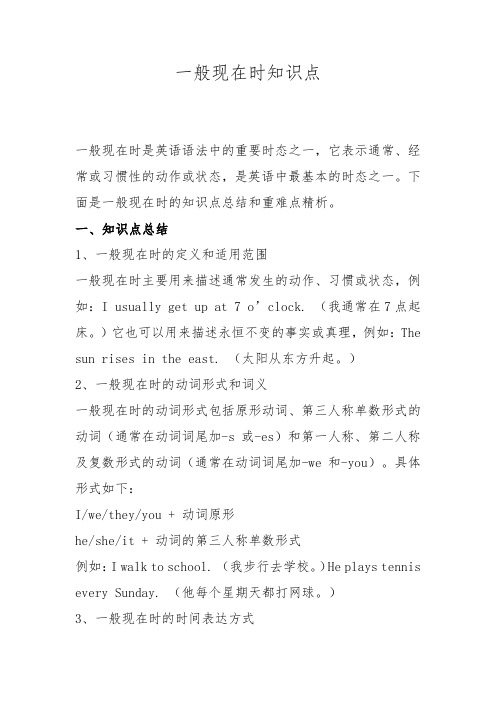
一般现在时知识点一般现在时是英语语法中的重要时态之一,它表示通常、经常或习惯性的动作或状态,是英语中最基本的时态之一。
下面是一般现在时的知识点总结和重难点精析。
一、知识点总结1、一般现在时的定义和适用范围一般现在时主要用来描述通常发生的动作、习惯或状态,例如:I usually get up at 7 o’clock. (我通常在7点起床。
)它也可以用来描述永恒不变的事实或真理,例如:The sun rises in the east. (太阳从东方升起。
)2、一般现在时的动词形式和词义一般现在时的动词形式包括原形动词、第三人称单数形式的动词(通常在动词词尾加-s或-es)和第一人称、第二人称及复数形式的动词(通常在动词词尾加-we和-you)。
具体形式如下:I/we/they/you + 动词原形he/she/it + 动词的第三人称单数形式例如:I walk to school. (我步行去学校。
)He plays tennis every Sunday. (他每个星期天都打网球。
)3、一般现在时的时间表达方式一般现在时的时间表达方式通常是通过时间状语来表示,例如:always(总是),usually(通常),often(经常),never(从不),sometimes(有时)等。
4、一般现在时的修辞手法修辞手法主要是通过语言表达方式来强调某种语气或情感,例如:使用情态动词can、may、must等来表达某种可能性或必要性,或者使用程度副词如completely(完全地)、absolutely(绝对地)等来强调某种程度。
二、重难点精析1、一般现在时与现在进行时的区别现在进行时表示正在进行的动作或状态,而一般现在时表示通常或习惯性的动作或状态。
例如:I am studying now. (我现在正在学习。
)I usually study in the evening. (我通常在晚上学习。
)2、一般现在时与将来完成时的联系将来完成时表示将来某个时间已经完成的动作或状态,而一般现在时表示现在或习惯性的动作或状态。

一般现在时七年级知识点一般现在时是英语语法中最基础的一个时态,也是最常用的一个时态。
它表示的是现在正在进行的动作或者现在的状况。
在七年级阶段,我们需要学会如何正确地使用一般现在时。
本文将重点介绍一些在七年级需要掌握的一般现在时的知识点。
一、动词原形在一般现在时中,我们需要使用动词原形(也叫基本形式)作为谓语动词。
例如:I play basketball every day.She reads books in her free time.注意:第三人称单数形式的动词要加上“-s”或“-es”。
例如:He reads books in his free time.She plays the piano every day.二、第三人称单数形式第三人称单数形式指的是以“-s”或“-es”结尾的动词形式,是在句子中表示第三人称单数主语时使用的动词形式。
例如:He likes to play soccer.She teaches English at the school.注意:有些动词的第三人称单数形式并不是以“-s”或“-es”结尾,例如“have”、“do”等。
这些动词在第三人称单数时不需要变化。
三、句型在一般现在时中,我们需要掌握以下两种基本的句型。
1. 主语+动词原形例如:I play basketball every day.They sing songs in the classroom.2. 主语+助动词“do/does”+动词原形例如:Do you like to eat pizza?Does she go to school by bus?注意:在第三人称单数形式的句子中,需要使用助动词“does”,例如:Does he like to play soccer?Does she play the piano every day?四、时间状语在一般现在时中,我们通常会加上时间状语来表明动作发生的时间或者频率。
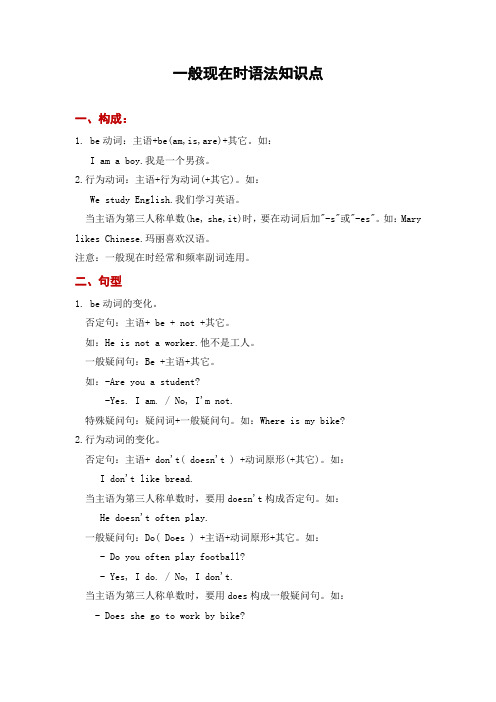
一般现在时语法知识点一、构成:1. be动词:主语+be(am,is,are)+其它。
如:I am a boy.我是一个男孩。
2.行为动词:主语+行为动词(+其它)。
如:We study English.我们学习英语。
当主语为第三人称单数(he, she,it)时,要在动词后加"-s"或"-es"。
如:Mary likes Chinese.玛丽喜欢汉语。
注意:一般现在时经常和频率副词连用。
二、句型1. be动词的变化。
否定句:主语+ be + not +其它。
如:He is not a worker.他不是工人。
一般疑问句:Be +主语+其它。
如:-Are you a student?-Yes. I am. / No, I'm not.特殊疑问句:疑问词+一般疑问句。
如:Where is my bike?2.行为动词的变化。
否定句:主语+ don't( doesn't ) +动词原形(+其它)。
如:I don't like bread.当主语为第三人称单数时,要用doesn't构成否定句。
如:He doesn't often play.一般疑问句:Do( Does ) +主语+动词原形+其它。
如:- Do you often play football?- Yes, I do. / No, I don't.当主语为第三人称单数时,要用does构成一般疑问句。
如:- Does she go to work by bike?- Yes, she does. / No, she doesn't.特殊疑问句:疑问词+一般疑问句。
如:How does your father go to work? 动词第三人称单数形式构成规则动词原形变第三人称单数的规则与发音规律同名词单数变复数大致相同,请认真观察。
1、大多数动词在词尾加“S”在清辅音后发音为[s],在浊辅音及元音后发音为[z]。
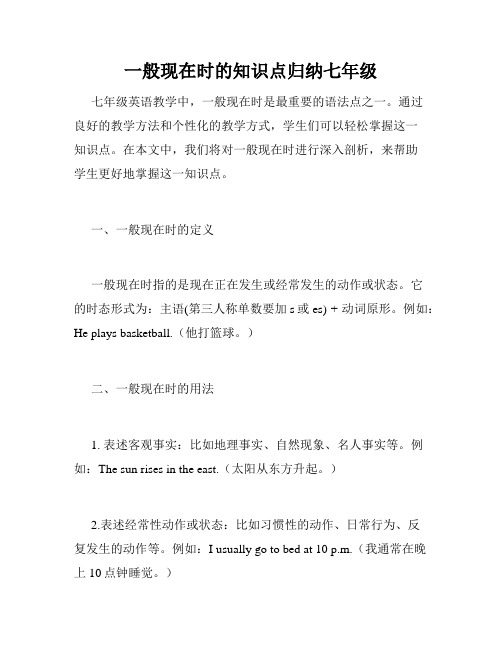
一般现在时的知识点归纳七年级七年级英语教学中,一般现在时是最重要的语法点之一。
通过良好的教学方法和个性化的教学方式,学生们可以轻松掌握这一知识点。
在本文中,我们将对一般现在时进行深入剖析,来帮助学生更好地掌握这一知识点。
一、一般现在时的定义一般现在时指的是现在正在发生或经常发生的动作或状态。
它的时态形式为:主语(第三人称单数要加s或es) + 动词原形。
例如:He plays basketball.(他打篮球。
)二、一般现在时的用法1. 表述客观事实:比如地理事实、自然现象、名人事实等。
例如:The sun rises in the east.(太阳从东方升起。
)2.表述经常性动作或状态:比如习惯性的动作、日常行为、反复发生的动作等。
例如:I usually go to bed at 10 p.m.(我通常在晚上10点钟睡觉。
)3.表述真理或普遍事实:比如科学定理、社会现象、人定律等。
例如:Water freezes at 0 degrees Celsius.(水在零度时结冰。
)4. 表示主语所具备的特征等性质。
例如:She is kind and friendly.(她友善又和蔼。
)三、一般现在时的标志词一般现在时没有专门的标志词,但在使用中,我们通常可以根据上下文来判断。
四、一般现在时的否定句和疑问句1.否定句:在be动词后加not,其他动词在前面加助动词do/does,其后紧随not。
例如:He does not run fast.(他跑得不快。
)2. 疑问句:将助动词do/does提前到主语前,其他句子成分不变。
例如: Do you like playing basketball?(你喜欢打篮球吗?)五、常见的时间状语时间状语指的是句子中表示时间的词或短语。
以下是常见的时间状语:1. every day (每天)2. every week (每周)3. every month (每月)4. every year (每年)5. on Monday (在星期一)6. in the morning (在早晨)7. at night (在晚上)8. at the weekend (在周末)六、一般现在时常见错误1. 第三人称单数动词形式错误:在第三人称单数主语后要加s/es。

一般现在时知识点总结1.句子结构:一般现在时的句子结构一般包括主语+动词+其他成分。
-主语:表示动作的执行者或状态的拥有者。
- 动词:一般现在时的动词形式常为原形动词,但第三人称单数形式需加-s或-es。
-其他成分:指出动作发生的时间、地点或方式等。
2. 第三人称单数形式:在一般现在时中,第三人称单数形式的动词需加-s或-es。
- 当主语为第三人称单数名词、代词或不定代词时,动词需加-s或-es。
例如:She walks to school every day.(她每天步行去学校。
)- 当主语以不发音的-s、-x、-sh、-ch或-o结尾时,动词需加-es。
例如:He watches TV every evening.(他每天晚上看电视。
)3.经常性动作:一般现在时通常用来表示经常性或习惯性的动作。
- 常与表示频率的短语连用,例如:every day(每天)、once a week(每周一次)、twice a month(每月两次)等。
4.准确性描述:一般现在时也用于描述客观真理、事实或普遍现象。
- 描述客观真理:例如:Water boils at 100 degrees Celsius.(水在100摄氏度时沸腾。
)- 描述事实:例如:The earth revolves around the sun.(地球绕着太阳旋转。
)- 描述普遍现象:例如:Cats eat fish.(猫吃鱼。
)5.目前状态:一般现在时也可用来描述目前的状态或存在。
- 描述目前状态:例如:She looks tired today.(她今天看起来很累。
- 描述存在:例如:There is a book on the table.(桌上有一本书。
)6.时间状语:一般现在时常与时间状语连用,以指出动作发生的时间。
- 表示经常性或习惯性的动作:例如:I always go to the park on Sundays.(我每个星期天都去公园。
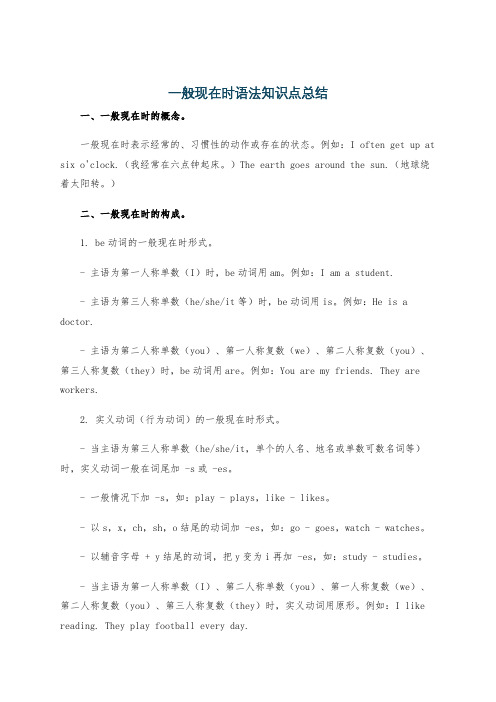
一般现在时语法知识点总结一、一般现在时的概念。
一般现在时表示经常的、习惯性的动作或存在的状态。
例如:I often get up at six o'clock.(我经常在六点钟起床。
)The earth goes around the sun.(地球绕着太阳转。
)二、一般现在时的构成。
1. be动词的一般现在时形式。
- 主语为第一人称单数(I)时,be动词用am。
例如:I am a student.- 主语为第三人称单数(he/she/it等)时,be动词用is。
例如:He is a doctor.- 主语为第二人称单数(you)、第一人称复数(we)、第二人称复数(you)、第三人称复数(they)时,be动词用are。
例如:You are my friends. They are workers.2. 实义动词(行为动词)的一般现在时形式。
- 当主语为第三人称单数(he/she/it,单个的人名、地名或单数可数名词等)时,实义动词一般在词尾加 -s或 -es。
- 一般情况下加 -s,如:play - plays,like - likes。
- 以s,x,ch,sh,o结尾的动词加 -es,如:go - goes,watch - watches。
- 以辅音字母 + y结尾的动词,把y变为i再加 -es,如:study - studies。
- 当主语为第一人称单数(I)、第二人称单数(you)、第一人称复数(we)、第二人称复数(you)、第三人称复数(they)时,实义动词用原形。
例如:I like reading. They play football every day.三、一般现在时的用法。
1. 表示经常或习惯性的动作。
- 常与表示频率的副词或短语连用,如:always(总是),usually(通常),often(经常),sometimes(有时),seldom(很少),never(从不),every day (每天),once a week(每周一次)等。

初中英语知识点归纳一般现在时的构成与用法一、一般现在时的构成一般现在时表示经常性、习惯性或客观事实等,构成方式如下:1. 肯定句:主语 + 动词原形/动词的第三人称单数形式例:I like reading books.(我喜欢读书。
)He eats an apple every day.(他每天吃一个苹果。
)2. 否定句:主语 + do not/does not + 动词原形例:They do not watch TV at night.(他们晚上不看电视。
)She does not play basketball on weekends.(她周末不打篮球。
)3. 疑问句:Do/Does + 主语 + 动词原形?例:Do you speak English?(你会说英语吗?)Does she go to school by bus?(她乘公交车去学校吗?)4. 特殊疑问句:特殊疑问词 + do/does + 主语 + 动词原形?例:What do you do in your free time?(你空闲时做什么?)When does the movie start?(电影什么时候开始?)二、一般现在时的用法一般现在时用于以下几种情况:1. 表示经常性或习惯性的动作或状态。
例:My mother often cooks dinner for us.(我妈妈经常给我们做晚饭。
)We usually go to the park on weekends.(我们通常在周末去公园。
)2. 表示客观事实、自然规律或科学真理。
例:The sun rises in the east.(太阳从东方升起。
)Water boils at 100 degrees Celsius.(水在100摄氏度沸腾。
)3. 表示现有状况或个人特征。
例:I have two cats.(我有两只猫。
)She lives in London.(她住在伦敦。
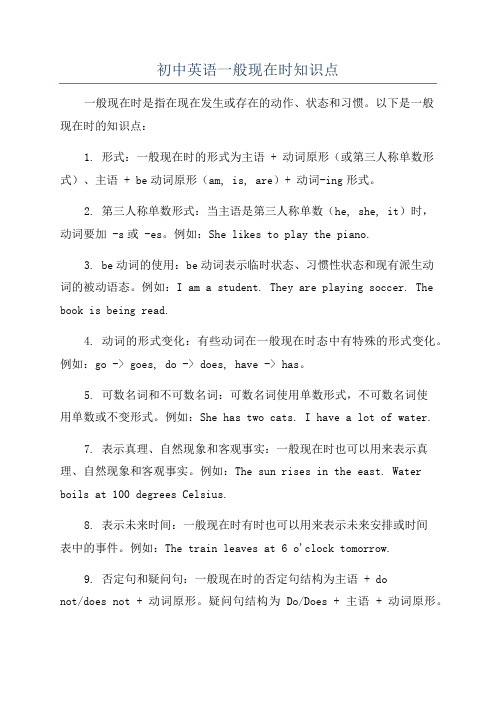
初中英语一般现在时知识点一般现在时是指在现在发生或存在的动作、状态和习惯。
以下是一般现在时的知识点:1. 形式:一般现在时的形式为主语 + 动词原形(或第三人称单数形式)、主语 + be动词原形(am, is, are)+ 动词-ing形式。
2. 第三人称单数形式:当主语是第三人称单数(he, she, it)时,动词要加 -s或 -es。
例如:She likes to play the piano.3. be动词的使用:be动词表示临时状态、习惯性状态和现有派生动词的被动语态。
例如:I am a student. They are playing soccer. The book is being read.4. 动词的形式变化:有些动词在一般现在时态中有特殊的形式变化。
例如:go -> goes, do -> does, have -> has。
5. 可数名词和不可数名词:可数名词使用单数形式,不可数名词使用单数或不变形式。
例如:She has two cats. I have a lot of water.7. 表示真理、自然现象和客观事实:一般现在时也可以用来表示真理、自然现象和客观事实。
例如:The sun rises in the east. Water boils at 100 degrees Celsius.8. 表示未来时间:一般现在时有时也可以用来表示未来安排或时间表中的事件。
例如:The train leaves at 6 o'clock tomorrow.9. 否定句和疑问句:一般现在时的否定句结构为主语 + donot/does not + 动词原形。
疑问句结构为Do/Does + 主语 + 动词原形。
以上是一般现在时的主要知识点,通过学习和掌握这些知识点,你就能正确运用一般现在时来描述现在的动作、状态和习惯。
![一般现在时知识点总结[1]1](https://img.taocdn.com/s1/m/9b894772443610661ed9ad51f01dc281e43a5656.png)
一般现在时知识点总结一、本次知识点归纳:表达经常性或习惯性的动作、状态、表示真理或客观事实。
二、重要知识点提示:一般现在时需要表示经常性的时间状语例如: always、usually、often、sometimes、everyday、in the morning/afternoon/evening、on Sundays等。
be动词的一般现在时有三种形式, 即: am, is, are(翻译为“是”)1.如果主语是第一人称I(我)时,be动词用am。
如:.a..student.I am 还可缩写成I'm am 与 not 不能缩写。
2.如果主语是you (你, 你们), they (他们, 它们, 她们)或名词复数(两个以上的人或物)时, be动词必须用are如: Are you twelve?are与主语还可缩写。
如: We're, They're, You're。
而are与 not可缩写成aren't3.如果主语是单数名词、不可数名词或第三人称单数代词(he, she, it)时, be动词用is。
如:My mother is a teacher.is也可与主语缩写,如: He's, My mother is = My mother's等。
但是This is不可缩写。
而is与not可缩写成 isn't4.句中含有be动词的陈述句变一般疑问句。
把be动词提到句首, be动词要变大写。
注意第一人称变第二人称。
回答时用yes或no表示, 结构: Yes, 主语+be动词, No, 主语+be动词+not。
5.句中含有be动词的肯定陈述句变否定句。
先找肯定陈述句中的be动词, 在be动词后加not.根据以上叙述我们可以把动词的用法以口诀的形式表述出来:我用am, 你用are, is跟着他(he), 她(she), 它(it);单数名词用is, 复数名词全用are。

初中英语语法知识之一般现在时一、一般现在时的定义一般现在时是英语中最基本的时态之一,用于描述经常发生的事情、普遍的真理、长期存在的状态等。
二、一般现在时的构成一般现在时的肯定句结构为:主语 + 动词原形(第三人称单数需加-s/-es)+ 其他。
例如:•He plays basketball every day.(他每天打篮球。
)•I like watching movies.(我喜欢看电影。
)一般现在时的否定句结构为:主语 + do/does not + 动词原形 + 其他。
例如:•He does not play basketball every day.(他不是每天打篮球。
)•I do not like watching movies.(我不喜欢看电影。
)一般现在时的疑问句结构为:Do/Does + 主语 + 动词原形 + 其他?例如:•Does he play basketball every day?(他每天打篮球吗?)•Do you like watching movies?(你喜欢看电影吗?)三、一般现在时的用法1. 描述日常习惯一般现在时经常用来描述日常习惯或经常发生的动作。
表示频率的副词有:always(总是)、often(经常)、usually(通常)、sometimes(有时候)、rarely(很少)、never(从不)等。
例如:•She always eats breakfast before going to school.(她上学前总是吃早餐。
)•They often go shopping on weekends.(他们经常在周末去购物。
)2. 表达客观事实或普遍真理一般现在时也被用来表达客观事实或普遍真理。
例如:•The Earth revolves around the sun.(地球绕太阳运行。
)•Water boils at 100 degrees Celsius.(水在100摄氏度沸腾。

语法专项:一般现在时一、定义一般现在时表示经常或习惯性的动作,也可表示现在的状态或主语具备的特征和能力。
用法:①表示现在的状态;My name is Jane. I’m twelve.②表示经常的或习惯性的动作;I often go to school by bus.③表示主语具备的特征和能力;He likes English very much.④表示客观事实或普遍真理等。
A year has four seasons.二、标志词①频率副词系列:always, usually, often, sometimes,never等;②every+时间系列:every day/week/month/year等;③介词短语系列:in the morning ,on Sundays等。
三、动词的变化1、be动词:am, is,are2、实义动词:动词原形、动词单三形式动词变单三形式的方法:①一般情况在动词词尾直接加s;②以s、x、ch、sh、o结尾的动词,在词尾加es;③以辅音字母+y结尾的动词,把y变成i,再加es;以元音字母+y 结尾的动词直接+s;如:fly –flies play –plays④特殊变化:have has四、句型结构(1)含有be动词的一般现在时的句型a.肯定句主语+am/is/are+其他.b.否定句主语+am/is/are+not+其他.c.一般疑问句Be动词+主语+其他?肯定回答:Yes,主语+be动词.否定回答:No,主语+be动词+not.d.特殊疑问句特殊疑问词+be动词+主语+其他?(2)含有实义动词的一般现在时的句型a.肯定句主语+动词原形+其他.主语+动词单三形式+其他.b.否定句主语+don’t+动词原形.主语+doesn’t+动词原形.c.一般疑问句Do/Does +主语+动词原形+其他?肯定回答:Yes,主语+do./does.否定回答:No,主语+don’t./doesn’t.d.特殊疑问句特殊疑问词 +do/does+主语+动词原形+其他?注:当主语是非你(you)非我(I)非复数时,动词要用单三形式。
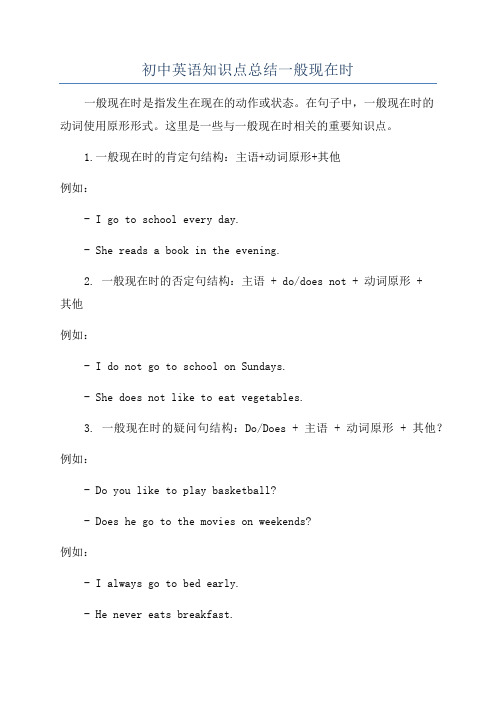
初中英语知识点总结一般现在时一般现在时是指发生在现在的动作或状态。
在句子中,一般现在时的动词使用原形形式。
这里是一些与一般现在时相关的重要知识点。
1.一般现在时的肯定句结构:主语+动词原形+其他例如:- I go to school every day.- She reads a book in the evening.2. 一般现在时的否定句结构:主语 + do/does not + 动词原形 +其他例如:- I do not go to school on Sundays.- She does not like to eat vegetables.3. 一般现在时的疑问句结构:Do/Does + 主语 + 动词原形 + 其他?例如:- Do you like to play basketball?- Does he go to the movies on weekends?例如:- I always go to bed early.- He never eats breakfast.5. 表示客观真理、规律或常识时,一般现在时可用于所有人称,不需要使用助动词do/does。
例如:- The sun rises in the east.- Water boils at 100 degrees Celsius.6. 当主语为第三人称单数时,动词需要变化。
一般情况下,加上-s 或-es。
例如:- She eats lunch at 12 o'clock.- The dog barks loudly.7.部分动词在第三人称单数时需要做变化- go→goes- do→does- have→has例如:- He goes to school by bus.- She does her homework every day.- My mother has a pet cat.8. 当主语为we, they, you或复数名词时,动词不需要做变化。

初中英语一般现在时的知识点归纳以下是简略的初中英语一般现在时的常见知识点归纳:一、一般现在时说明的是发生在现在的情况或事实,常用的句式有:1、第三人称单数加es。
比如:He speaks English.2、以s结尾的动词。
如:She goes to school every day.3、动词to be。
例如:We are students.4、动词to do作实义动词时(也就是说做“办事”),习惯上用do而非does。
比如:I do my homework every day.5、其他动词加-s,-es,或-ies。
例如:She reads a book every day.二、一般现在时的肯定句的一般结构为:主语+动词的一般现在式。
例如:He speaks English every day.三、一般现在时的疑问句的一般结构为:Do/Does+主语+动词原形。
例如:Do you speak English?四、一般现在时的祈使句没有谓语动词,而是以动词原形开头,来表示请求、劝告、命令或者建议。
例如:Let’s go.五、一般现在时使用一般现在时也可以表示经常性或者习惯性的动作发生。
例如:She usually takes a bus to school.综上所述,初中英语一般现在时是指发生在现在的情况或事实,一般句的肯定句的一般结构为:主语+动词的一般现在式,而疑问句为Do/Does+主语+动词原形,祈使句以动词原形开头,来表示请求、劝告、命令或者建议,一般现在时也可以表示经常性或者习惯性的动作发生。
英语学习者一定要熟练掌握这些基本的知识,以便更自信地应用这一时态。
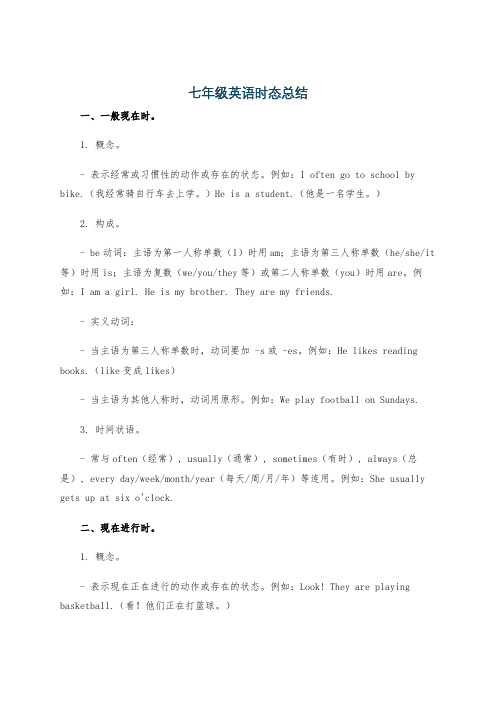
七年级英语时态总结一、一般现在时。
1. 概念。
- 表示经常或习惯性的动作或存在的状态。
例如:I often go to school by bike.(我经常骑自行车去上学。
)He is a student.(他是一名学生。
)2. 构成。
- be动词:主语为第一人称单数(I)时用am;主语为第三人称单数(he/she/it 等)时用is;主语为复数(we/you/they等)或第二人称单数(you)时用are。
例如:I am a girl. He is my brother. They are my friends.- 实义动词:- 当主语为第三人称单数时,动词要加 -s或 -es。
例如:He likes reading books.(like变成likes)- 当主语为其他人称时,动词用原形。
例如:We play football on Sundays.3. 时间状语。
- 常与often(经常), usually(通常), sometimes(有时), always(总是), every day/week/month/year(每天/周/月/年)等连用。
例如:She usually gets up at six o'clock.二、现在进行时。
1. 概念。
- 表示现在正在进行的动作或存在的状态。
例如:Look! They are playing basketball.(看!他们正在打篮球。
)2. 构成。
- be动词(am/is/are)+动词的 -ing形式。
例如:I am reading a book. Heis watching TV. They are having lunch.3. 动词 -ing形式的构成规则。
- 一般在动词原形末尾加 -ing。
如:go - going, play - playing。
- 以不发音的字母e结尾的动词,先去掉e,再加 -ing。
如:write - writing, have - having。

一般现在时定义:一般现在时:表示通常性、规律性、习惯性的状态或者动作(有时间规律发生的事件)的一种时间状态。
句子结构当主语是第三人称单数时:肯定句:主语+动词的第三人称单数+其他否定句:主语+doesn't+动词原形+其他一般疑问句:Does+主语+动词原形+其他肯定回答:Yes,主语+does否定回答:No,主语+doesn't特殊疑问句:特殊疑问词+一般疑问句当主语不是第三人称单数时:肯定句:主语+动词原形+其他否定句:主语+don't+动词原形+其他一般疑问句:Do+主语+动词原形+其他肯定回答:Yes,主语+do否定回答:No,主语+don't要注意,句式结构错则全局都错。
变化规律具体运用1.表示经常的或习惯性的动作,常与表示频率的时间状语连用。
时间状语: always, usually,regularly,everymorning/night/evening/day/week/year,often,sometimes,occasionally ,from time to time,twice a week,rarely,seldom,once a month, hardly, ever,never.e.g. I leave home for school at 7:00 every morning.2.表示主语具备的性格、能力、特征和状态。
e.g. I don't want so much.Ann Wang writes good English but does not speak well.比较:Now I put the sugar in the cup.I am doing my homework now.3.表示客观事实和普遍真理。
e.g The earth moves around the sun.Shanghai lies in the east of China.4.在时间状语从句和条件状语从句中,常用一般现在时代替将来时。
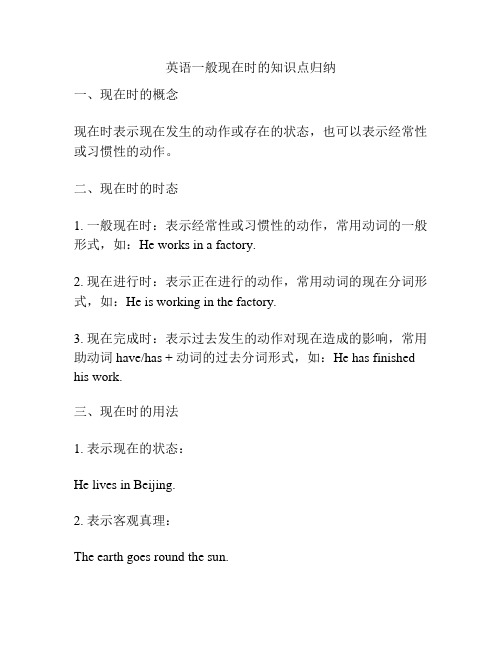
英语一般现在时的知识点归纳
一、现在时的概念
现在时表示现在发生的动作或存在的状态,也可以表示经常性或习惯性的动作。
二、现在时的时态
1. 一般现在时:表示经常性或习惯性的动作,常用动词的一般形式,如:He works in a factory.
2. 现在进行时:表示正在进行的动作,常用动词的现在分词形式,如:He is working in the factory.
3. 现在完成时:表示过去发生的动作对现在造成的影响,常用助动词have/has + 动词的过去分词形式,如:He has finished his work.
三、现在时的用法
1. 表示现在的状态:
He lives in Beijing.
2. 表示客观真理:
The earth goes round the sun.
3. 表示现在的计划、安排:
I'm leaving for Shanghai tomorrow.
4. 表示经常性或习惯性的动作:He often goes shopping on weekends.。

2024七年级下册英语语法知识点1一、一般现在时一般现在时表示经常性、习惯性的动作、状态或真理。
1.构成:主语+谓语动词(第三人称单数要加-s/-es)+其他。
2.用法:(1)经常性动作或状态:表示经常性、习惯性的动作、状态或真理。
例如:I eat an apple every day.(我每天吃一个苹果。
)(2)客观事实:表示一般性的真理、经验、客观事实等。
例如:The earth goes around the sun.(地球绕着太阳转。
)二、一般过去时一般过去时表示过去一些时间里发生的动作、存在的状态或经过的事情。
1.构成:主语+谓语动词(过去式形式)+其他。
2.用法:(1)过去一些时间的动作或状态:表示过去一些时间里发生的动作或存在的状态。
例如:I watched a movie last night.(昨晚我看了一部电影。
)(2)过去的习惯性动作:表示过去经常性、习惯性的动作。
例如:He often played basketball when he was a child.(他小时候经常打篮球。
)三、一般将来时一般将来时表示将来一些时间里将要发生的动作或存在的状态。
1.构成:主语+will/shall +动词原形+其他。
2.用法:(1)将来发生的动作或状态:表示将来一些时间里将要发生的动作或存的状态。
例如:I will go shopping tomorrow.(我明天将要去购物。
)(2)意愿、请求、建议等:表示意愿、请求、建议等。
例如:Will you please help me?(请你帮帮我好吗?)四、现在进行时现在进行时表示现在(说话瞬间)进行的动作。
1.构成:主语+be(am/is/are)+动词-ing+其他。
2.用法:(1)表示现在进行的动作:表示现在说话瞬间正在进行的动作。
例如:They are playing basketball now.(他们现在正在打篮球。
)(2)将来计划或安排:表示将来一些时间要进行的计划或安排(常与表示将来的时间状语连用)。
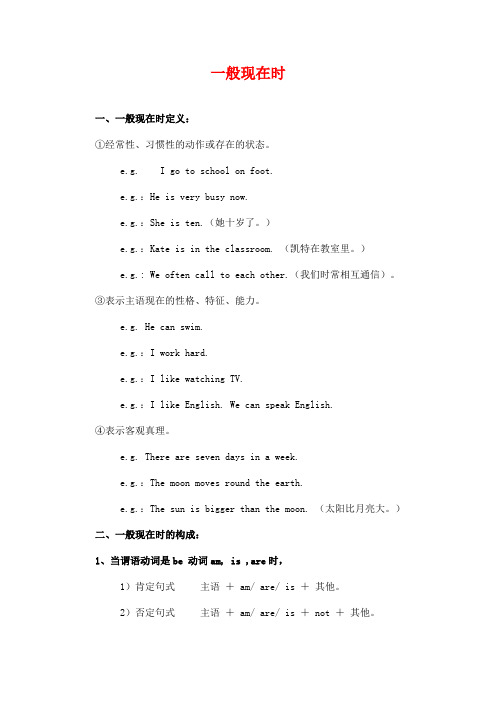
一般现在时一、一般现在时定义:①经常性、习惯性的动作或存在的状态。
e.g. I go to school on foot.e.g.:He is very busy now.e.g.:She is ten.(她十岁了。
)e.g.:Kate is in the classroom. (凯特在教室里。
)e.g.: We often call to each other.(我们时常相互通信)。
③表示主语现在的性格、特征、能力。
e.g. He can swim.e.g.:I work hard.e.g.:I like watching TV.e.g.:I like English. We can speak English.④表示客观真理。
e.g. There are seven days in a week.e.g.:The moon moves round the earth.e.g.:The sun is bigger than the moon. (太阳比月亮大。
)二、一般现在时的构成:1、当谓语动词是be 动词am, is ,are时,1)肯定句式主语+ am/ are/ is +其他。
2)否定句式主语+ am/ are/ is + not +其他。
3)一般疑问句Am/ Is/ Are +主语+其他?肯定回答 Yes, 主语(必须是代词)+ am/ is/ are否定回答 No, 主语(必须是代词)+ am/ is/ are + not(必须用缩写形式 isn't/aren't)e.g.:Danny is a good student.Danny isn’t a good student.Is Danny a good student?Yes, she is.No,she isn’t.2、当谓语动词是行为动词(实义动词)时1)当主语是第一人称 (I / we) ; 第二人称 (you) 及第三人称复数(they及复数的名词)时:①肯定句主语+行为动词原形+其他②否定句主语+don’t +行为动词原形+其他③一般疑问句Do +主语+行为动词原形+其他肯定回答 Yes, 主语(必须是代词)+do否定回答 No, 主语(必须是代词)+don’te.g.:They have lunch at 12:00.They don’t have lunch at 12:00.Do they have lunch at 12:00?Yes, they do.No, they don’t.2)当主语是第三人称单数 (she/ he/ it及单数的名词) 时①肯定句主语+行为动词的单三形式+其他②否定句主语+doesn’t +行为动词原形+其他③一般疑问句Does +主语+行为动词原形+其他肯定回答 Yes, 主语(必须是代词)+ does否定回答 No, 主语(必须是代词)+doesn’te.g.:Jenny speaks English very well.Jenny doesn’t speak English very well.Does Jenny speak English very well?Yes, she does.No, she doesn’t.3.当谓语动词是情态动词+行为动词时:1)肯定句主语+(情态动词 +行为动词原形)+其他2)否定句主语+(情态动词 +not+行为动词原形)+其他3)一般疑问句情态动词+主语+行为动词原形+其他?肯定回答 Yes, 主语(必须是代词)+情态动词否定回答 No, 主语(必须是代词)+情态动词 +not(必须是缩写形式can’t, mustn’t, shouldn’t, needn’t等)e.g.:Tom can speak Chinese. 汤姆会说汉语。
一般现在时
一、一般现在时定义:
①经常性、习惯性的动作或存在的状态。
e.g. I go to school on foot.
e.g.:He is very busy now.
e.g.:She is ten.(她十岁了。
)
e.g.:Kate is in the classroom. (凯特在教室里。
)
e.g.: We often call to each other.(我们时常相互通信)。
③表示主语现在的性格、特征、能力。
e.g. He can swim.
e.g.:I work hard.
e.g.:I like watching TV.
e.g.:I like English. We can speak English.
④表示客观真理。
e.g. There are seven days in a week.
e.g.:The moon moves round the earth.
e.g.:The sun is bigger than the moon. (太阳比月亮大。
)
二、一般现在时的构成:
1、当谓语动词是be 动词am, is ,are时,
1)肯定句式主语+ am/ are/ is +其他。
2)否定句式主语+ am/ are/ is + not +其他。
3)一般疑问句
Am/ Is/ Are +主语+其他?
肯定回答 Yes, 主语(必须是代词)+ am/ is/ are
否定回答 No, 主语(必须是代词)+ am/ is/ are + not(必须用缩写形式 isn't/aren't)
e.g.:Danny is a good student.
Danny isn’t a good student.
Is Danny a good student?
Yes, she is.
No,she isn’t.
2、当谓语动词是行为动词(实义动词)时
1)当主语是第一人称 (I / we) ; 第二人称 (you) 及第三人称复数(they及复数的名词)时:
①肯定句主语+行为动词原形+其他
②否定句主语+don’t +行为动词原形+其他
③一般疑问句Do +主语+行为动词原形+其他
肯定回答 Yes, 主语(必须是代词)+do
否定回答 No, 主语(必须是代词)+don’t
e.g.:They have lunch at 12:00.
They don’t have lunch at 12:00.
Do they have lunch at 12:00?
Yes, they do.
No, they don’t.
2)当主语是第三人称单数 (she/ he/ it及单数的名词) 时
①肯定句主语+行为动词的单三形式+其他
②否定句主语+doesn’t +行为动词原形+其他
③一般疑问句Does +主语+行为动词原形+其他
肯定回答 Yes, 主语(必须是代词)+ does
否定回答 No, 主语(必须是代词)+doesn’t
e.g.:Jenny speaks English very well.
Jenny doesn’t speak English very well.
Does Jenny speak English very well?
Yes, she does.
No, she doesn’t.
3.当谓语动词是情态动词+行为动词时:
1)肯定句主语+(情态动词 +行为动词原形)+其他
2)否定句主语+(情态动词 +not+行为动词原形)+其他
3)一般疑问句情态动词+主语+行为动词原形+其他?
肯定回答 Yes, 主语(必须是代词)+情态动词
否定回答 No, 主语(必须是代词)+情态动词 +not(必须是缩写形式can’t, mustn’t, shouldn’t, needn’t等)
e.g.:Tom can speak Chinese. 汤姆会说汉语。
Tom can’t speak Chine se. 汤姆不会说汉语。
Can Tom speak Chinese? 汤姆会说汉语吗?
Yes, he can.
No, he can’t.
三.动词第三人称单数词尾变化有三种形式:
(1)一般动词在词尾加-s,-s在清辅音后读/s/,在浊辅音或元音后读/z /,ds读/dz/,ts读/ts/。
如:
help→helps,know→knows,get→gets,read→reads
(2)以字母s,x,ch,sh或有些以o结尾的动词加-es,-es读/iz/。
如:
guess→guesses,fix→fixes,teach→teaches,wash→washes
注意:go→goes do→does
(3)以辅音字母+y结尾的动词,先变y为i,再加-es,-ies读/iz/。
如:
carry→carries,fly→flies
注:在play→plays/pleiz/,say→says/sez/中,字母y前为元音字母,第三人称单数形式直接在动词后面加-s。
(4)特殊词例外。
如:be→is,have→has
四、对do的理解
例:We don’t (not do) our homework in the afternoon.
答案:don’t do
解析:do是一个比较难理解的词,它有三个含义: a)是所有行为动词的总称;b)是助动词,无实义;c)是一个具体的行为动词“做,干”。
此句中给出的do指“做,干”,not指把此句变为否定句,故须在do前加助动词don’t。
本文由索罗学院整理。